
How to Install an NX Nitrous Kit - Nozzle System on Your 1986-2012 Mustang GT
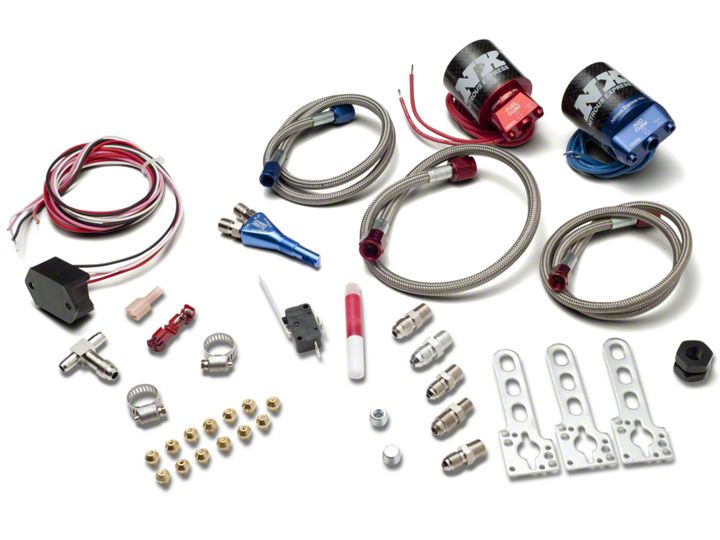
Shop Parts in this Guide
Installation
You have selected the most advanced, researched, field tested, state of the art nitrous system manufactured to date. The most important thing to do now is READ…UNDERSTAND…AND FOLLOW these instructions. If there is something you don’t understand, STOP! Call the factory tech department for help. 9:00 AM to 4:00 PM CST 940-767-7694.
The installation procedures are divided into 5 sections. Please pay particular attention to each one:
1. Mounting the bottle.
2. Drilling the manifold & plumbing the nozzles
3. Plumbing the fuel system.
4. Wiring the system
5. Testing the system.
Before starting any installation steps:
1. Disconnect the negative battery terminal.
2. Never use Teflon tape on any system fittings. Tape debris will cause numerous problems ranging from fouled solenoids to blocked jets. Use the red liquid NX thread sealer supplied with the system. A drop is all it takes.
3. Have your nitrous bottle filled by a reliable source, being sure it is filled to capacity with filtered “Nytrous ” nitrous oxide. For filling station locations log on to: www.nitrousexpress.com.
MOUNTING THE BOTTLE
The nitrous bottle should be mounted in the trunk area or outside of the passenger compartment. If this is not possible or practical a NHRA approved blow down tube and vent fitting (PN’s 11708, 11709) must be installed. The positioning of the bottle should be as shown in diagram “A”. This will allow the siphon tube to be covered at all times.
The mounting brackets should be assembled on the bottle with the short bracket approx. 2” from the bottom, on 10 lb bottles the long bracket should be place approx. 7” above the lower one, on 15lb bottles the upper bracket should be approx. 12” above the lower bracket. Use this mock up as a template to locate the four mounting bolt holes. Note: Before drilling holes be sure to check for clearance beneath the mounting surface i.e.: fuel tank, fuel lines, brake lines.
ILLUSTRATION A
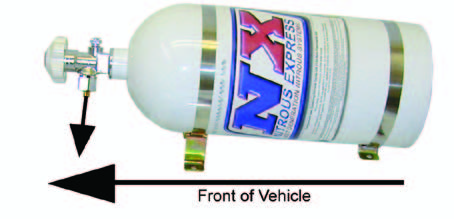
REMOVING AND DRILLING THE INTAKE MANIFOLD
Before any modifications are made to the engine compartment, we suggest that you make a diagram of all hoses, wiring, and linkages.
1. Remove the intake manifold. If you have question regarding this step please consult a service manual on your engine type.
2. Mark the center of each runner approximately 1-1.5 inches from the manifold flange. This distance is not critical, however the higher up the runner the nozzle is placed the harder the “Hit” when the system is engaged.
3. This step is critical to a successful installation. The use of a Bridgeport style mill is suggested. The nozzle mounting hole should be “tilted” back toward the manifold plenum 1-1.5 degrees to ensure adequate valve cover clearance. Each hole must be in alignment, front to rear, and top to bottom. If your system is furnished with Shark Nozzles drill each runner using an “R” bit. Tap each hole to a uniform depth using the furnished 1/8 NPT tap. If your system is furnished with Piranha Nozzles drill each runner using a “1/4” bit. Tap each hole to a uniform depth using the furnished 1/16 NPT tap.
4. Debur the holes inside and out.
5. Install the nozzles in the tapped holes using a Teflon based paste sealer. Be sure each nozzle is installed to a uniform depth.
6. Using the pictures in Diagram “B” as a guide, map out how you want your NX system to look after it is installed.
7. If you have purchased an NX Next Generation Rail system position the rails on the manifold above the previously installed nozzles and mark the location of each fitting on a rail “Flat”. Note: The rail may be shortened, by cutting an equal length off of each end at this time if it is excessively long. Drill the rail using an “I” bit. Using a bottom hole tap, thread these holes 5/16 x 24. Install the rail fittings using NX red liquid thread sealer. Using a, snug fitting, aircraft style, drill bit, debur the entire length of the inside diameter of each rail orifice. Drill both ends of each rail to a 1” depth with an “R” bit and tap 1/8 NPT. Debur the entire rail again thoroughly; any debris left inside the rails will cause future trouble. Install the fuel and nitrous solenoids on the end of the appropriate rail, again using NX thread sealant. Install the furnished 1/8 NPT plugs on the unused rail end. Note: The fuel solenoids always mount in the front; the nitrous solenoids may be mounted on either end.
8. After determining the desired position of each rail, cut and debur the 3/16 stainless hard lines to the proper lengths. Using a 37-degree flaring tool prepare one end of each line and install the appropriate color sleeve and B-nut. Starting on both ends of each rail bend the stainless 3/16 tubing to position the rail as desired. Install a B-nut and sleeve, flair and install these two “positioning” lines. Cut, bend, and flair each of the remaining lines to match the originals.
9. If you have purchased a conventional style NX system install the solenoids on the distribution blocks, using blue for nitrous and red for fuel. Position the solenoids on each side of the manifold so as not to interfere with any linkages or other equipment. Cut, bend, install B-nuts, sleeves and flair each 3/16 line to support the solenoids in the desired location.
10. Using the supplied jumper lines and billet distribution “Y’s” connect the nitrous solenoids together and repeat the step on the fuel solenoids.
11. After all installation on the manifold is complete flush all lines and orifices using compressed air. Attention to detail here will save you time and money in the long run. Do not shortcut this step! Reinstall the intake manifold and carburetor; hook up all vacuum lines, and linkages using the diagram prepared before disassembly. Reconnect the fuel lines and tighten securely.
12. Now install the nitrous supply line leading from the bottle to the nitrous solenoid. NOTE: Tape over both ends of the nitrous supply line before beginning. Route line carefully to prevent the possibility of restricting nitrous flow. If routed under vehicle, locate and drill a 3⁄4 inch diameter hole in a suitable area near the bottle valve for the main line. Starting at the bottle nipple (Do not attach to the bottle nipple yet) route the line to the engine compartment. Following the factory fuel lines is usually the best path. Note: Keep maximum clearance between all moving parts, suspension components and hot engine components, securing the supply line where possible (“Zip-Ties” work best here). Be especially careful of the feed line being near any “HOT” electrical leads, even a small spark will result in a nitrous leak. If the line is too long, coil the excess near the bottle, if it is too short; try rerouting the line to gain length. If this does not work contact the factory for a custom length supply line. After the nitrous supply line is in place remove the tape from both ends. Install the nut and nipple on the bottle and tighten firmly. Before you attach the nitrous supply line purge it of any foreign matter that may have accidentally entered the line during installation. Do so by removing the tape used during installation and blowing compressed air through the feed line. (Have an assistant hold the end of the hose aimed away from the car and any people. Wearing a glove is recommended). Immediately after the purging operation, connect the main feed line to the N2O solenoids and the nitrous bottle, tighten securely.
BE SURE ALL NUTS ON SOLENOID MAGNETS ARE TIGHT!
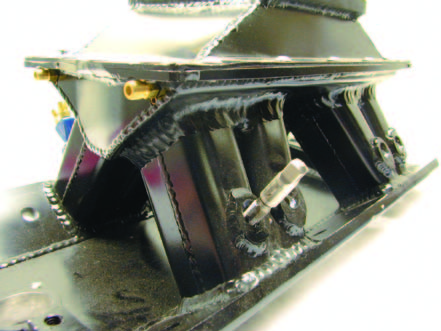
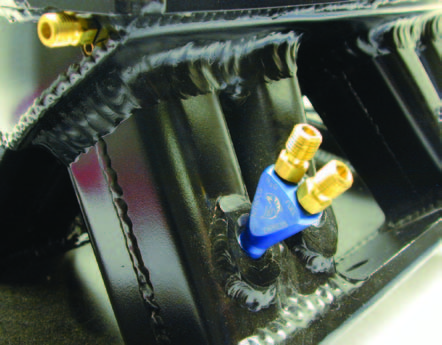
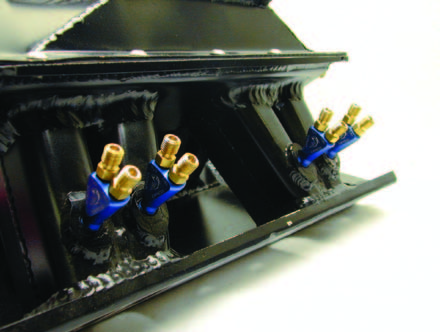
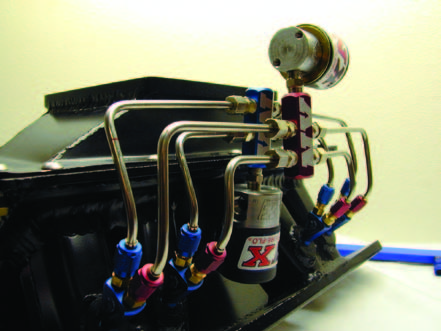
PLUMBING THE FUEL SYSTEM
A stock fuel pump will work with our “HITMAN” nitrous systems only! All others require an after market high performance pump. Please refer to the fuel pump recommendation chart below:
10.00 or slower ET=110 GPH or larger
9.00 to 9.99 ET=250 GPH or larger
8.00 to 8.99 ET=300 GPH or larger
7.00 to 7.99 ET=400 GPH or larger
6.99 or quicker=500 GPH
Remember the fuel pump is an integral part of your NX system, for reliable trouble free service your pump must match your cars performance.
1. All NX systems are designed to use the reliable, inexpensive Holley fuel pressure regulator (Holley PN 12-803, NX PN 15951). Any high quality, accurate regulator such as Magna Flow can be used.
2. Your NX system requires a dedicated fuel pressure regulator. If you use a multi stage system a regulator must be used for each stage. Mount the regulator as close to the fuel solenoid as practical.
3. The N2O system fuel regulator must be fed by direct pump pressure. Do not connect the nitrous system fuel regulator through the carb regulator.
4. All NX systems are designed to be tuned by flowing fuel pressures. This information can be found on the jetting card under FFP. Using the NX Master Flo-check (PN 15519 or Pro Series 15529) this pressure can easily be calibrated. These flowing pressures are only a base line tune up and will generally be very rich. Fine-tune your combination by reading your spark plugs after a full throttle pass. When the tune up for your combination is correct, the spark plug should be almost completely white with little or no color on the porcelain. For the ultimate in reliability and safety, our fuel pressure safety switch (PN 15708) should be used.
5. Note: A higher fuel pressure will not result in a “safer” system. Too much fuel can cause the same type of engine damage as too little fuel.
6. It is not necessary or recommended to use a dedicated fuel pump for your nitrous system, if you have followed our fuel pump guidelines. However if you feel it is necessary to run a dedicated pump you must run a bypass return line with a maximum.050 orifice to the fuel tank. Special fuel solenoid bypass fittings (PN 16204) are available to make this an easy task. This is mandatory to prevent fuel line airlocks. If you ignore this advice a massive nitrous flash fire and explosion will result!!!
7. All NX systems are calibrated at 1000-PSI bottle pressure. The safe operating range is 900 PSI to 1050 PSI.
DIAGRAM “C”

WIRING SOLENOIDS
1. Mount the red arming switch within easy reach, and plain sight of the driver.
2. The system is furnished with a universal wide-open throttle switch. This WOT micro-switch is designed to work with the universal mounting bracket. It’s maximum capacity is 10 AMPS and should only be used to activate low amp draw accessories or in conjunction with a relay.
A. Assemble the micro-switch on the mounting bracket using the supplied 3⁄4” 4-40 bolts and nuts. The switch can be mounted in several different configurations, select the position you require and tighten the bolts. Do not over-tighten, the plastic micro switch can be damaged.
B. The mounting bracket is made of easily bendable material and may be formed to any configuration that will allow it to place the WOT switch in the proper location.
C. The activation arm on the micro-switch is extra long. This allows you to twist, bend, or cut it to aid in the ease of installation. If you have a 4500 series Dominator the WOT mount is pre-made and designed to bolt to the left front carb stud, just bolt on and its ready to go!
3. The best power source for the nitrous system is the terminal on the back of the alternator labeled “BAT”. The next best power source is directly to the “Positive” post on the battery. Do not try to “Splice” into the factory wiring harness for a power supply, this will not have adequate amperage to operate the solenoids. If desired a 60 amp fuse may be installed in this circuit.
4. Follow diagram “C” when wiring the system, the relay must be used in all applications.
5. Solder all connections for a permanent trouble free installation.
6. The nitrous and fuel solenoids are rated only for intermittent duty. Do not engage either solenoid for more than 15 continuous seconds. Solenoids that have “burned or scorched” electro-magnets will not be replaced under warranty.
COMPLETING AND TESTING THE SYSTEM
1. After all components have been assembled on the vehicle and each piece has been verified for correct installation and the wiring has been rechecked and verified to be correct, it is time to test the system.
2. Do not open the bottle valve at this time.
3. Reconnect the negative battery cable.
4. Using the red, lighted toggle switch “Arm” the nitrous system.
5. Test the solenoid operation by “Engaging” the activation or WOT switch. All solenoids should “click “. If they do not recheck all wiring until the problem is found and corrected.
6. Open the nitrous bottle and check all connections for leaks. Retighten any fitting or connection that leaks and recheck.
7. Start the engine and check for fuel leaks, correct any fuel leak problems before proceeding.
8. Adjust the fuel pressure regulator to the recommended pressure at this time. NX recommends using a Master Flo-Check (PN # 15519) or the Master Flo-Check Pro (PN # 15529)
9. Do not purge the system into the motor i.e. Rev the engine and engage the system. Piston damage will result. The nitrous system should only be engaged when the engine is at full throttle, under load, with the car in motion.
10. All NX systems are intended for off road use only and should only be used in that context.
11. Choose a suitable testing area, your local racetrack is best. Drive the vehicle to verify all operations are normal and the throttle linkage is operating properly.
12. Pre-stage the vehicle, arm the system, purge the air from the supply line using 3 one-second bursts from the purge valve (PN 15600-15601). Stage and launch the vehicle, shutting off at the 60ft mark. Check all components and verify their proper operation.
13. Repeat the staging procedure, the system should be crisp and responsive, make a full throttle pass and shut the engine off for an 8 spark plug check to verify each cylinder is getting equal amounts of N2O and fuel. The plugs should all look alike, having little or no color. if they are sooty or black the fuel pressure must be reduced for optimum performance.
SAFETY TIIPS
Do not attempt to start engine if nitrous has been accidentally injected while the engine was not running. Disconnect coil wire and turn motor with throttle wide open for several revolutions before attempting to restart. If it is not possible to disable the ignition then the spark plugs must be removed and the engine cleared or all nitrous before attempting to start engine.
- Never permit oil, grease, or any other readily combustible substances to come into contact with nitrous cylinders, valves, solenoids, hoses and fittings. Oil and certain gases (such as oxygen and nitrous oxide) may combine to produce a flammable condition.
- Never interchange solenoids or other appliances used for one compressed gas with those used for another.
- Identify the gas content by the label on the bottle before using. If the bottle is not identified to show the gas contained, return the bottle to the supplier.
- Do not deface or remove any markings, which are used for content identification.
- Cylinder valves should be closed except when nitrous is actually being used.
- Notify supplier of any condition, which might have permitted any foreign matter to enter the valve or bottle.
- Never drop or violently strike the bottle
- Keep valves closed on all empty bottles to prevent accidental contamination. Open the bottle valve for an instant to clear opening of any possible dust or dirt before usage. Aim bottle outlet away from all body parts. Do not point it in the direction of a person.
POWER TUNING TIPS
Nitrous oxide works well with all applications; 4 cycle, 2 cycle, diesel, and rotary engines. Each one has individual tuning characteristics, and these tips apply generally to each one. Nitrous oxide is referred to as “Liquid Supercharging” because it, in effect, does the same thing as a mechanical supercharger, forcing more fuel and oxygen into each cylinder, thus producing more power. The biggest enemy of all supercharged, turbo charged and nitrous injected engines is “DETONATION”. The use of higher-octane fuel, and or a combination of better fuel and timing retard can control this. Remember detonation is a spark plug, head gasket and engine “KILLER”.
1. Your engine should be tuned to its maximum power prior to nitrous usage.
2. The ignition is an integral part of the nitrous system and must be able to ignite the mixture under very high cylinder pressures. The hotter the spark the better!
3. In stock engine applications and street usage the spark plugs should be at least 2 steps colder than stock. Do not use platinum tip, extended tip or any plug with multiple ground straps or split ground straps. When in doubt about heat range always go one step colder. A spark plug that is to “Hot” will cause detonation, burned plugs, poor performance, and engine damage. In competition engines always use the coldest plug available. Never use an extended tip plug in a racing engine.
4. The NX nitrous system is so advanced, (technology, engineering, and workmanship) that huge amounts of timing retard is not required. You may run as much timing as you normally would, if you have the octane required to prevent detonation. We recommend 1 degree timing retard for each 50 horsepower boost as a starting point. Your engine may need more or less depending on your combination.
5. Your fuel system is also an integral part of the nitrous system, be sure it is in top shape and all filters are clean.
6. Engine operating temperature should be between 160 and 200 degrees prior to nitrous usage.
7. Never “lug” your engine and hit the nitrous system, use the system at wide-open throttle only, nitrous should not be used below 2000 rpm’s. If you do any of the above a serious “Back Fire” could result in engine damage.
8. The better the exhaust system the better the nitrous system will work.
9. Do not attempt to drill or alter the jets, solenoids, or the tubes in the nitrous plate. These items are engineered to their maximum capability. Any modification you can make will decrease power and destroy engine parts.
10. Do not mix or attempt to match any other brand solenoids with this system. Do not attempt to mix or match any other brand plate or nozzle with this system. Do not attempt to use any other brand kit as a second stage with this system. Our nitrous technology is far superior to any of our competitors. Any attempt at this could lead to serious engine damage.
11. All of our systems are designed to operate at 1000-PSI bottle pressure. This is extremely important and cannot be stressed enough. If your bottle pressure is below 1,000 PSI the system will run rich and will not produce the advertised horsepower. If the bottle pressure is above 1,050 PSI the system will run lean, possibly damaging engine parts. This pressure is easily monitored by using a NX liquid filled pressure gauge (PN 15509). Note: When the ambient temperature is below 97 degrees a bottle warmer is required (PN 15940 or 15941). An NX bottle jacket (PN15945 or 15946) will help stabilize bottle pressure in the winter and summer.
CAUTION: NEVER USE AN OPEN FLAME TO HEAT A NITROUS BOTTLE. THIS IS A VERY DANGEROUS AND POTENTIALLY FATAL PRACTICE!!!!!!!!!!!
12. A purge valve (PN15600-15601) is recommended on all NX systems. When the weather begins to get hot a purge valve is worth up to a tenth of a second on a 1⁄4 mile pass. Note: The correct purging procedure for drag racing is:
1. Complete the burnout.
2. Light the pre-stage bulb.
3. Push the purge button three times, one second each.
4. Stage immediately, GO FAST.
13. If there is a question about the purity of your nitrous supply, a filter (PN15610 or 15607) should be used when refilling your bottle. Just attach the filter to your bottle when you take it to be refilled. Contaminated nitrous will cause serious damage to the nitrous solenoids and possibly to your engine. This is a lifetime renewable filter.
14. If you have questions about the suitability of your torque converter or gear ratios, call the factory tech line for the inside scoop.
15. Your nitrous bottle should be turned off when not in use (even between runs). An NX remote bottle opener (PN11107) will make this task much easier.
16. Start with the lowest power setting in your system. Don’t try to be the track “Hero” on your first pass. Remember start out small and work your way up, NX systems produce more real horsepower than any other brand on the market today.
17. If the solenoids must be disassembled for cleaning or rebuilding always use the proper wrench (PN 15921). Do not use any clamping devise on the solenoid tower, instant non-warranty, damage will result.
18. If you run an NX system of 150 horsepower you must use a high octane racing type fuel. These are some tips to help you choose and maintain the correct fuel for your application:
A. The most important statistic you should look for in the fuel specifications is the “MON” or motor octane number. In most cases the higher the number the more timing you can run and detonation will not be a problem
B. Most V-8 or V-12 engines with stock compression will run on “93” unleaded pump gas with up to 150 horsepower boost, most 4 or 6 cylinders with stock compression can use up to 75 horsepower.
C. Racing engines with 10-1 compression or higher must run racing fuel. The higher the compression, and the higher the boost, the higher the “MON” must be.
D. With nitrous usage usually the highest “MON” available is the one that should be used.
E. All NX systems are calibrated to use fuel with.730 specific gravity or “SG”. If you use a fuel with a lower “SG” you must use a higher fuel pressure to compensate for the lighter fuel. If you use a fuel with a higher “SG”, a lower fuel pressure will be required. Most unleaded pump gas is.730 SG or above
F. Racing fuel should be stored in an airtight, dark container. Exposure to atmosphere allows very important elements to evaporate, lowering the octane of the fuel. Sunlight oxidizes the lead contained in racing fuel, since this is the most important ingredient used to raise octane it must be protected.
G. Never leave the fuel in your car between race days. This allows evaporation of the very important “High end” hydrocarbons and lowers the octane of the fuel.
H. Never buy racing fuel from and underground or vented storage tank. Always demand to see where and how the fuel is stored, a sealed drum is the only correct way.
I. AV gas or aviation fuel is not compatible with nitrous usage, don’t be tempted by the cheap price, instant engine damage will result!
J. For a fuel recommendation contact your NX dealer.
19. All vehicles, including full competition race cars, must have an alternator to provide adequate amperage required by today’s racing accessories. Add up all the amps required by your car, you’ll be surprised!
20. If you notice some of the N2O-fuel orifices are not perfectly aligned in your NX plate system, do not be concerned. This misalignment has been engineered into the system to direct fuel to specific cylinders.
21. If you have trouble with your NX system or any related parts, call your dealer first. If you still need help call the factory tech line 940-767-7694 9:00 AM - 4:00 PM Mon-Fri. We are the nitrous experts and will give straight answers to your questions.
In conclusion……….
This instruction sheet and power tuning tips are valid only for a NX system. If you have a kit from another manufacturer this information will not help you! A tune up from any other brand of nitrous kit will not work with the NX “Next Generation” technology.
DO NOT LISTEN TO:
- YOUR BUDDY!
- YOUR BUDDY’S FRIEND!
- THE LOCAL NITROUS GURU!
- ANY ARTICLE IN ANY MAGAZINE
If you follow the foregoing suggestions, your NX system will operate trouble free and provide years of thrills. ABOVE ALL REMEMBER TO RACE SAFE AND HAVE FUN!!!!!!!!!!!!!!!!!!!!!!!!!!!!!!!!
Related Guides
-
Installation
-
Installation
-
Installation

